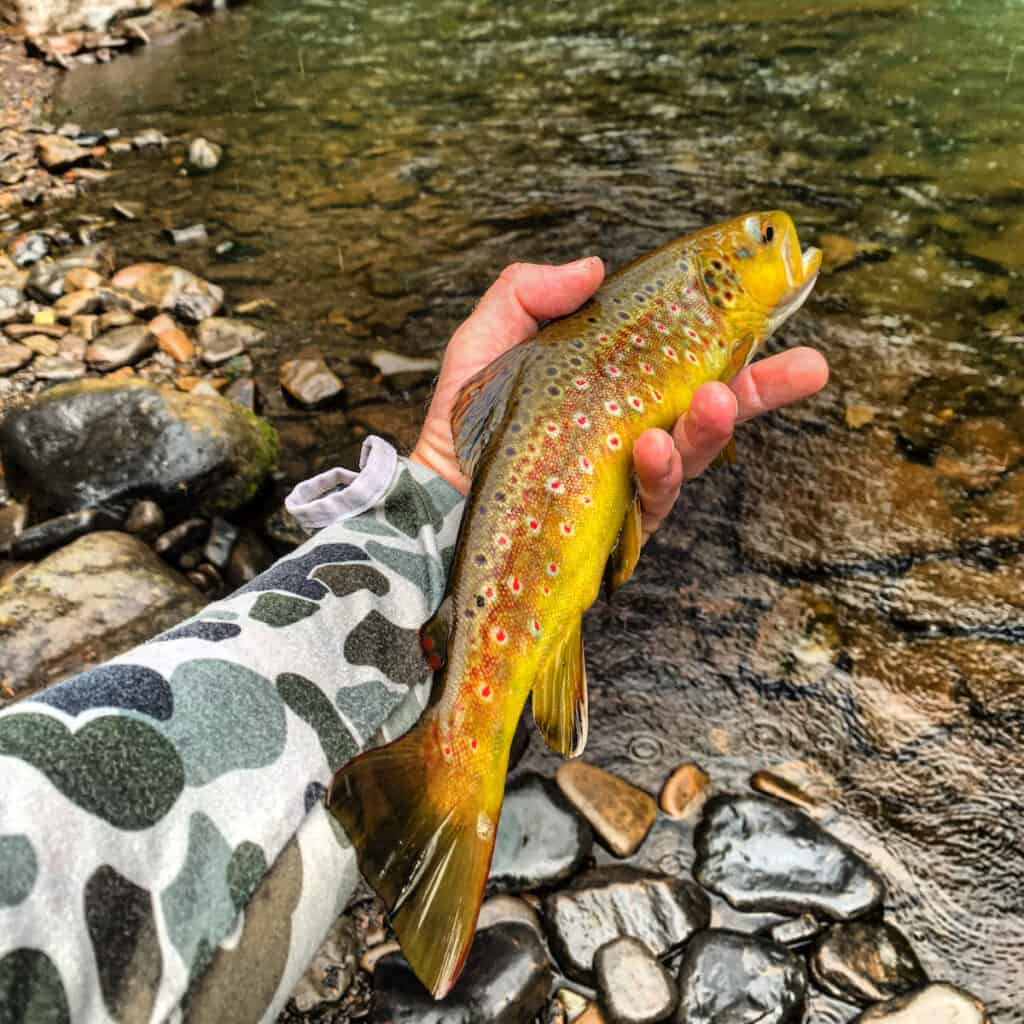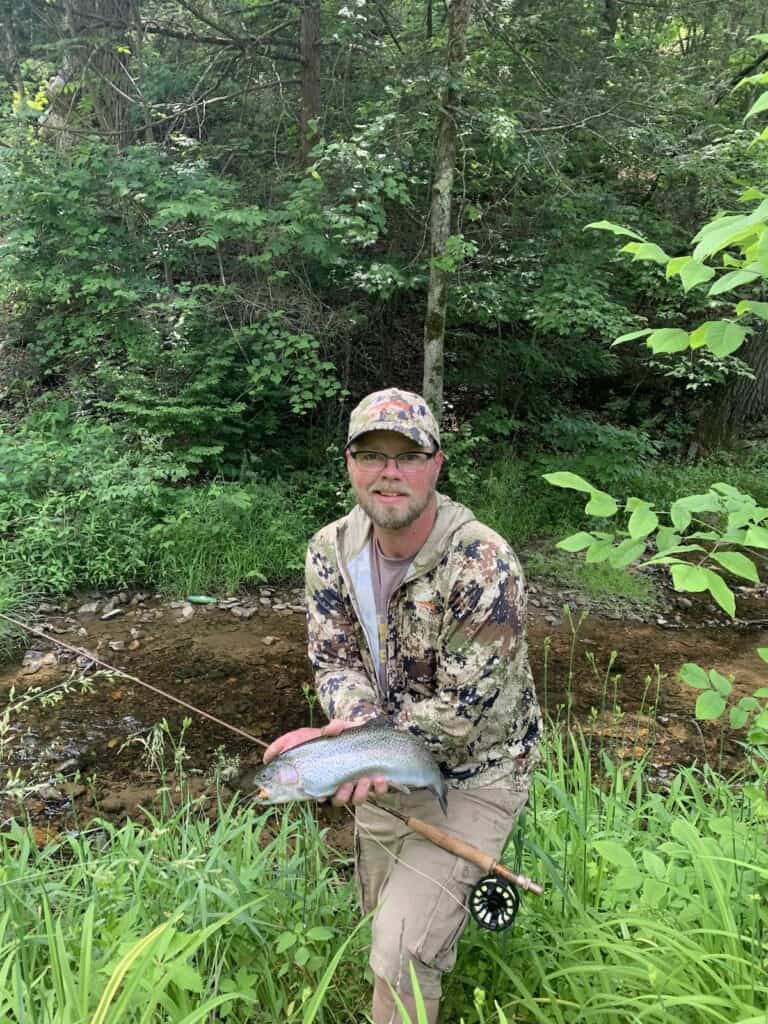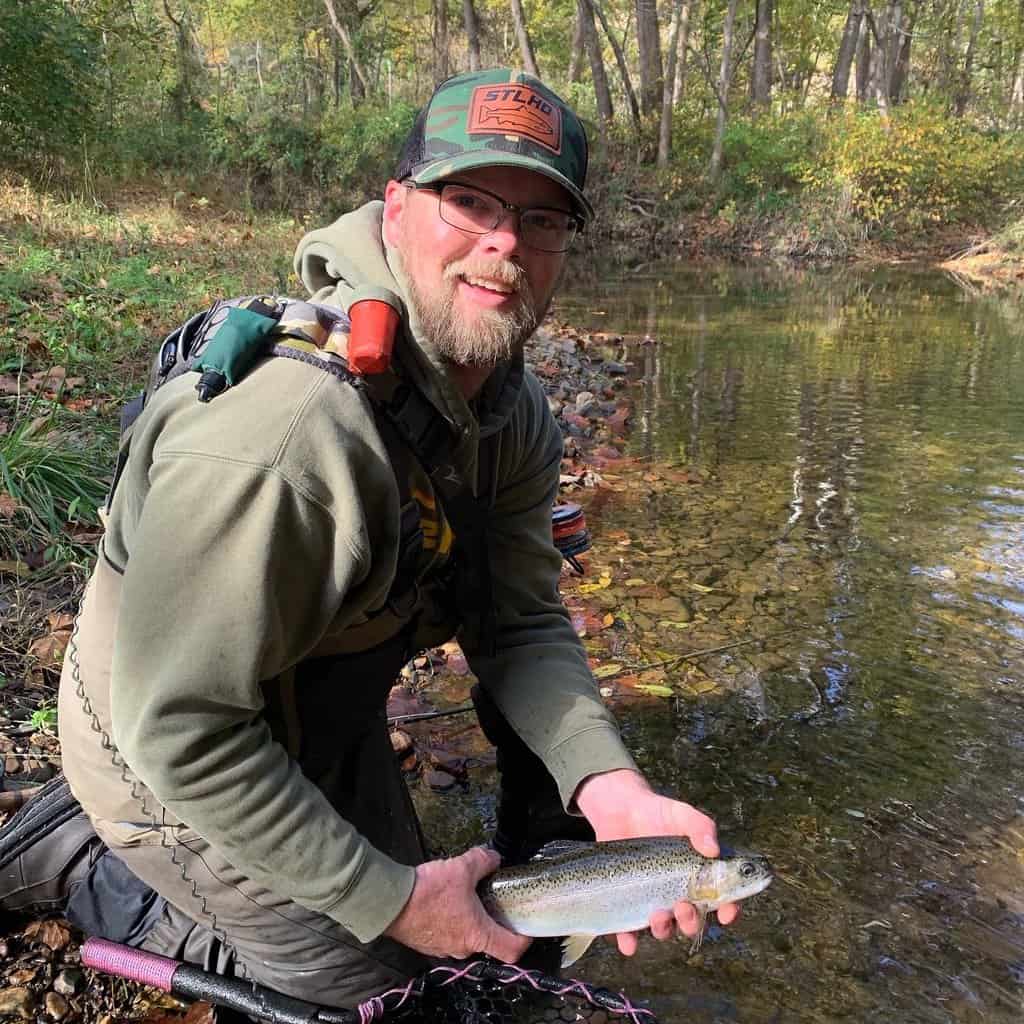With its cool waters flowing out of the Blue Ridge and Appalachian mountains, Maryland has tremendous trout fishing water.
Maryland may get more acclaim for its Chesapeake Bay blue crabs, but the state Lefty Kreh calls home has produced brown trout over 18 pounds, along with impressive rainbow and brook trout.
We got to catch up with Maryland fishing guide John Peake, who shared his insights on his local trout waters.
The following rivers, creeks and lakes will give trout anglers in Maryland the best shots at memorable days on the water in the coming year.
Best Trout Rivers and Creeks

These streams, including several cold-running tailwaters, provide the best chances to catch trout in the flowing waters of Maryland.
North Branch Potomac River
The North Branch of the Potomac River begins in West Virginia but soon forms the state boundary.
Maryland anglers should focus on the river below Jennings Randolph Lake, where the Army Corps of Engineers can release colder water in the summer months to keep the tailwater section suitable for trout.
The section just below the dam now supports wild populations of both brown and brook trout, a highlight for anglers looking for a more challenging quarry.
The tailwater area is fairly remote and very scenic, making it an ideal destination for a trout expedition.
Be sure to check the most updated regulations, as there are sections of the Potomac that are catch-and-release only.
Farther downstream toward Westport, the warming river transitions into a smallmouth bass fishery.
Access: Roads run near both the Maryland and West Virginia banks of the North Branch from the dam down about 8 miles to the towns of Bloomington and Piedmont.
Savage River

Flowing into the North Branch of the Potomac from the Savage River Reservoir, the Savage River tailwater is open to year-round trout fishing under special regulations.
As of this writing, brook trout must be at least 12 inches to keep, while brown trout must be at least 18 inches to harvest, and only two fish of each species can be kept. The special regulations promote a popular and productive fishery.
“The tailwater of the Savage is known for big browns,” Peake said, and they seem to have a particular taste for ants and other land insects.
“In the spring, you’ll see more of those terrestrials, and I like to go with a dry (fly) and a dropper,” Peake said. “Ants, grasshoppers, beetles and inchworms all work well.”
Peake warned that because the water is typically very clear, the lightest leader material you can get away with, the better.
Access: Savage River Road follows the river close enough that anglers can drive along it to stop and fish. Savage River Outfitters, which sits along the road, has a variety of flies, rods and gear for your outing.
Gunpowder Falls
One of Maryland’s most popular brown trout fisheries, Gunpowder Falls from Prettyboy Reservoir downstream offers scenic trails, secluded areas, and potentially outstanding brown trout fishing.
The vast majority of the trout in this tailwater section are browns; the Maryland Department of Natural Resources puts the estimate at more than 90 percent of all trout here.
However, there are some brook trout and rainbow trout mixed in.
The prime seven miles of stream between the Prettyboy Dam and Blue Mount Road are a catch-and-release fishery. Only flies and artificial lures are allowed.
Access: Bunker Hill Road in Hereford has public parking and stream access.
Big Hunting Creek
If you’re looking for good-sized, wild brown trout in small water, Big Hunting Creek offers that opportunity.
This storied stream, rarely wider than 20 feet at any point, was the first in Maryland to be restricted to fly fishing and catch and release where it flows inside Cunningham Falls State Park.
A streamside statue of legendary angler Joe Brooks evokes Big Hunting Creek’s rich fishing history in Maryland.
Access: West of Thurmont, Rte. 77 (a.k.a. Foxville and Rocky Ridge roads) follows Big Hunting Creek and features pull-offs and family campgrounds inside Cunningham Falls State Park.
Casselman River
For anglers looking for good shots at willing and agreeable stocked fish, the Casselman River in northern Maryland is a popular destination.
Casselman River Bridge State Park is located just off Rte. 40/Main Street in Grantsville is a particularly scenic and accessible stretch of the river just south of where the stream flows into Pennsylvania.
The state stocks rainbow trout every year in the spring and fall, and tributaries to the Casselman have decent numbers of brook trout as well.
Access: Casselman Road off of Rte. 40 in Casselman River State Park offers easy stream access.
Fifteenmile Creek
Inside the Green Ridge State Forest, near Flintstone, Fifteenmile Creek is a small and scenic stream that Peake likes to fish when easy access is a priority.
“It’s a pretty route to take, and they stock that body of water two or three times a year with both rainbows and browns,” he said.
Fifteenmile Creek winds throughout the park, with a host of campsites right along its banks, before flowing into the Potomac River. For a family trip that offers good access and cooperative fish, Fifteenmile can be a great bet.
Access: Fifteen Mile Creek Road follows along the creek for many miles south of the Pennsylvania state line, almost to the confluence with the Potomac. You’ll find multiple stream access spots inside the Green Ridge State Forest.
Youghiogheny River
A four-mile stretch of this river from the Sang Run Road crossing upstream (south) to the Deep Creek Hydro-Electric Generating Station offers catch-and-release fishing for rainbows.
And not just any rainbows, according to state officials. They stock a “warm water” strain of this trout that has proven more resilient when faced with summer water temperatures.
It sounds like it’s working: State biologists estimate that more than 1,300 trout per mile inhabit this reach of the Youghiogheny in far-western Maryland, including those rainbows plus brown trout that occasionally top 5 pounds.
Besides the C&R rules, anglers may also only use artificial lures and flies to help reduce injuries to released trout.
The river, also known as the “Yough” or “Yawk,” gets its tongue-tying full name from a Native American phrase that means, roughly translated, “river that flows in a contrary direction.” Unlike many Maryland rivers, it flows from south to north on its way toward Pennsylvania.
The Youghiogheny also is Maryland’s first designated Wild and Scenic river, with those protections coming in 1976.
Access: About 500 feet after Sang Run Road crosses the Youghiogheny, there is a public put-in for kayakers and canoers and access for shore anglers.
Patapsco River
On the Petapsco River, anglers will have shots at rainbow trout pushing toward 20 inches, as well as a host of other freshwater species.
Chubs, shiners and minnows are all present in good numbers on the river, which provide ample sustenance for larger rainbows.
The Petapsco flows out of Liberty Reservoir to the Chesapeake Bay south of Baltern. It also supports smallmouth, rock and striped bass along the way, but you’ll find trout in the stretches closest to Liberty farther west.
Dropping temperatures in October will typically have the rainbows feeding more actively. You can predictably catch them from fall up through late May or early June.
Access: Petapsco Valley State Park offers anglers parking, access, and easy wading opportunities in the prime trout fishing section. There are paved parking lots off Rte. 40 in the Hollofield Area in the town of Ellicott City.
Best Trout Lakes
The following trio of lakes offer some of the best stillwater trout fishing opportunities in Maryland.
Deep Creek Lake
Covering more than 3900 acres with more than 69 miles of shoreline, Deep Creek Lake is Maryland’s largest inland body of water and one of its best trout lakes.
Peake said that Deep Creek Lake can be a reliable place to target trout, especially for anglers with a boat.
While trout fishing can be tough in many state waters during the hottest months of summer, Deep Creek Lake’s depths of more than 70 feet provide a cold refuge where you can find trout holding this time of year.
The southwestern arm of the lake features its deepest drops and holes, plunging more than 50 feet, and will give you your best chance at trout in the warmer months.
Access: Deep Creek Lake State Park offers a public boat launch on the eastern shoreline, as well as camping and other amenities.
Liberty Reservoir
At more than 3,000 acres, Liberty is one of the largest and most diverse fishing lakes in Maryland. Here anglers stand a chance to catch stripers, smallmouth bass, walleye, catfish, crappie, largemouth bass and, of course, rainbow and brown trout.
Liberty Reservoir is a public drinking water source, and boaters must sign an affidavit that they use their boats solely on certain reservoirs. Additionally, no outboards are allowed, so anglers need a paddle-, pedal-, or electricity-powered craft.
At 144 feet deep, the reservoir stays cold enough throughout the summer to keep the trout comfortable, especially in the hot Maryland summers.
The southernmost portion of the reservoir has the deepest holes, and those drops are where you’ll have the most luck in July and August.
Keep in mind that shad are the plentiful forage here, so spoons mimicking them will be your best bet.
Access: Boat Dock Road and Service Road in Eldersburg both have public launches.
Lake Habeeb
If you’re looking for a quiet and peaceful getaway minus the jet-skis and yachts, give Lake Habeeb in Rocky Gap State Park a try.
Gasoline-powered motors are prohibited on Lake Habeeb, although boaters with electric- or hand-powered craft can be on the lake 24 hours a day, seven days per week.
The state has placed artificial reefs in Lake Habeeb over the years to give some structure to attract the brown and rainbow trout it stocks every year.
The deepest parts of the lake are in the southwest quadrant, where it pushes 50 feet. It’s a good bet to hunt for rainbows and browns at those depths once the summer warms up the water temperatures.
A walking trail runs along the northeastern shore of the lake and the drop-off on this northeastern side is fairly deep, offering an opportunity to catch trout from shore before it gets too hot.
Wading or kayak anglers would be wise to target this stretch in the shoulder seasons of spring and fall.
One neat feature here is a state-supported “tackle loaner” program, where kids can use refurbished rods and reels free for the day. Add in canoe and kayak rentals, and you don’t have to bring much to Lake Habeeb to have a memorable day of fishing.
Access: Pleasant Valley Road NE gives anglers access to Lakeside Loop Trail to the boat ramp in Rocky Cap State Park.
Acknowledgment
We would like to thank guide John Peake of Chesapeake Bay Fly for sharing his knowledge of Maryland trout fishing.

